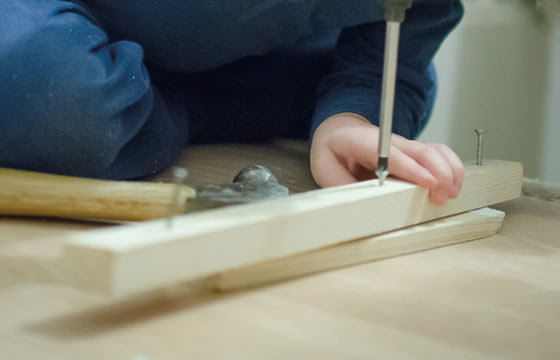 My grandson and his grandfather are in the shed. Heads together, small hands and large search through the box of wooden offcuts, pulling out random pieces and deciding on suitability. 'We're making a car, Grandma,' the little boy announces as I arrive. 'It's for my sister.'
My grandson and his grandfather are in the shed. Heads together, small hands and large search through the box of wooden offcuts, pulling out random pieces and deciding on suitability. 'We're making a car, Grandma,' the little boy announces as I arrive. 'It's for my sister.'
So I watch as the two work together in an Aladdin's cave of drills, jigsaws and screws, heads close, blond curls and silver crop, the little serious voice and the deep responses, confirming and directing. Learning and teaching.
Later, the small wooden car sits on the table next to the teddy bear bikkies, while we have morning tea in the garden.
'That's just lovely,' I say. 'Even the wheels go round.' 'It's blue,' he says proudly. Blue as the sky, blue as a bird's egg, blue as his eyes.
It seems so little to ask for - the ancient promise of peace, families sitting 'unafraid, under their own fig tree', Micah's beautiful image of God's peace and prosperity. (Micah 4:4)
In so many parts of the world, peace and prosperity are unimaginably distant. Every night the television shows footage of an endless stream of refugees, indistinguishable humanity, recognisable by the weary desperation of their gestures, their bewildered gaze. They are grateful to find what little haven can be provided in dusty camps on the borders of states hardly more stable than the one they have fled.
There are more displaced persons on the move today then there were after World War II. Dispossession is here, too, even in the 'Lucky Country'. I walk past a silent figure, head bowed, sitting on the cold pavement outside the supermarket. A handwritten card with his name on it is propped before him. My trolley is full, and hard to steer to where my car is parked, ready to haul a week's food and groceries home to fill my fridge and pantry. I am ashamed of the little I place in the meagre collection in his upturned cap.
Like the disciples' encounters with the Risen Lord, we struggle in the gap between the historic reality of our time and place in the world, and the promise of the Kingdom which Jesus taught and which is both now and yet to come. The peace of Christ is both deeply recognisable and elusive.
Over and over, Jesus tells his followers not to be afraid. And his last bequest to us, as he enters a new way of being with us, is an assurance not that we will be spared fearful times, but that we will be able  to be peaceful despite it all, because he has won peace for us, and gives peace to us in his unfailing presence and promise. As Bishop Joe Grech used to pray, raising the Host, 'this is Jesus, who will never abandon us.'
So, as we pray at every Mass, we wait in joyful hope for the coming of the Kingdom. The Eucharist is the place out of which the peace of Christ flows for us. We gather around the table, as rag-tag a bunch as the very first of Jesus' friends, and we share his life in the bread and wine, blessed and broken.
Then we go out into the world, taking his words and his life with us, and tend our little or large patch. And we take Christ's peace with us. Sometimes we manage to get all the way home without losing it!
‘Peace is hand-crafted,’ Pope Francis reminds us. In choosing Francis of Assisi as his patron, he placed peace and peacemaking at the heart of his ministry.
Right up to the end, the followers of Jesus still expected that his peace would be won at the end of a sword. But peace can never come out of fear, aggression, exclusion, and demonising the ‘other’. Peace is hand-crafted. It comes when we choose to share, to connect, to be merciful, to sow God’s love where there is hatred.
Peace makes gardens, and tables to sit around, families and communities who look after one another. Peace accepts differences of belief and opinion. Peace demands courage and faith, even in the face of terror. Peace is made daily. Anyone can break the peace. It takes craftsmanship to make it.
In a shed in a small village in Galilee, a little boy played with scraps of wood, and became a carpenter. His father, Joseph, taught him to measure and shape, to work patiently even with cross-grained and difficult materials, and to smooth and fit yokes for people that made their burdens light and easy to carry. He learnt how to heft beams big enough to hang a man from; and he carried his own cross up the hill alone, until Simon stepped forward to help.
And he showed us at the last, the centre and core of peace-making: forgiveness. When he forgave the worst that evil could muster against him, he showed us how love defeats hate, and ‘builds a heaven in hell’s despair.’ (William Blake, The Clod and the Pebble.)
If we want to follow him, that is what we too are called to do.